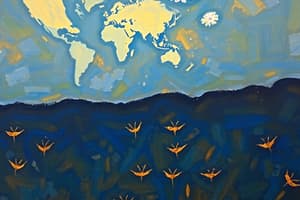Podcast
Questions and Answers
What is the smallest continent that is also a country?
What is the smallest continent that is also a country?
Australia
How many oceans are there in the world?
How many oceans are there in the world?
- Six
- Five (correct)
- Seven
- Four
The Arctic Ocean is the largest ocean in the world.
The Arctic Ocean is the largest ocean in the world.
False (B)
Match the following oceans with their respective characteristics:
Match the following oceans with their respective characteristics:
What percentage of the Earth's surface is covered by water?
What percentage of the Earth's surface is covered by water?
How many continents are there in the world?
How many continents are there in the world?
Which ocean is the largest and deepest in the world?
Which ocean is the largest and deepest in the world?
The Arctic Ocean is the smallest ocean in the world.
The Arctic Ocean is the smallest ocean in the world.
Match the oceans with their characteristics:
Match the oceans with their characteristics:
What is the unique feature of the Atlantic Ocean?
What is the unique feature of the Atlantic Ocean?
Flashcards are hidden until you start studying
Study Notes
Continents
- Eurasia is a term used to describe Europe and Asia combined.
- Australia is the smallest continent, also a country, and an island surrounded by water on all sides, located entirely in the southern hemisphere.
Australasia
- Australia, New Zealand, and several other islands form Australasia.
- The Great Barrier Reef and the Great Australian Desert are two notable features of Australia.
Formation of Continents and Oceans
- Millions of years ago, all continents formed a single supercontinent called Pangaea.
- Over time, Pangaea split into pieces, which drifted away from each other.
- The space between the pieces filled up with water, forming continents and oceans.
Oceans
- There are five oceans in the world: Pacific, Atlantic, Indian, Arctic, and Southern.
The Pacific Ocean
- The Pacific Ocean is the largest and deepest ocean in the world, almost circular in shape.
- It separates the Americas from Asia and Australia.
- The Mariana Trench, the world's deepest trench (10,994 m), lies in the Pacific Ocean.
The Atlantic Ocean
- The Atlantic Ocean is the second largest ocean, shaped like the letter 'S'.
- It separates North and South America from Europe and Africa.
- The Mid-Atlantic Ridge, a submerged mountain range, is a unique feature of the Atlantic Ocean.
The Indian Ocean
- The Indian Ocean is the third largest ocean, named after the country India.
- Asia lies to its north, Australia to its east, and Africa to its west.
- The Arabian Sea and the Bay of Bengal are two important parts of the Indian Ocean.
The Southern Ocean
- The Southern Ocean surrounds the continent of Antarctica.
- It is formed by the merging of the southern parts of the Pacific, Atlantic, and Indian Oceans, lying in the southern hemisphere.
The Arctic Ocean
- The Arctic Ocean is the smallest ocean, mostly located within the Arctic Circle, and covered with ice all the time.
- The North Pole, the northernmost point on earth, is located in the Arctic Ocean, and the surrounding area is frozen throughout the year.
Continents
- The Earth's surface is divided into 7 continents: Asia, Africa, Antarctica, Australia, Europe, North America, and South America.
- Continents are large landmasses surrounded by water on all sides.
- Asia is the largest continent, occupying one-third of the Earth's land area.
- Africa is the second-largest continent, surrounded by the Mediterranean Sea, the Atlantic Ocean, and the Indian Ocean.
- North America is the third-largest continent, stretching from the Arctic Circle to the southern border of Panama.
- South America is the fourth-largest continent, connected to North America by the Isthmus of Panama.
- Antarctica is the fifth-largest continent, surrounded by the Southern Ocean and covered in ice throughout the year.
- Europe is the sixth-largest continent, located in the northern hemisphere and sharing borders with Asia.
- Australia is the smallest continent, also an island, and is located entirely in the southern hemisphere.
Oceans
- There are 5 oceans: Pacific Ocean, Atlantic Ocean, Indian Ocean, Arctic Ocean, and Southern Ocean.
- The Pacific Ocean is the largest and deepest ocean, separating the Americas from Asia and Australia.
- The Atlantic Ocean is the second-largest ocean, separating North and South America from Europe and Africa.
- The Indian Ocean is the third-largest ocean, located between Asia, Australia, and Africa.
- The Southern Ocean surrounds Antarctica and is formed by the merging of the southern parts of the Pacific, Atlantic, and Indian Oceans.
- The Arctic Ocean is the smallest ocean, mostly located within the Arctic Circle and covered with ice throughout the year.
Studying That Suits You
Use AI to generate personalized quizzes and flashcards to suit your learning preferences.




